From Hate-Watching to GMOs: Highlights of the HSE Science Battles’ Third Semi-Finals
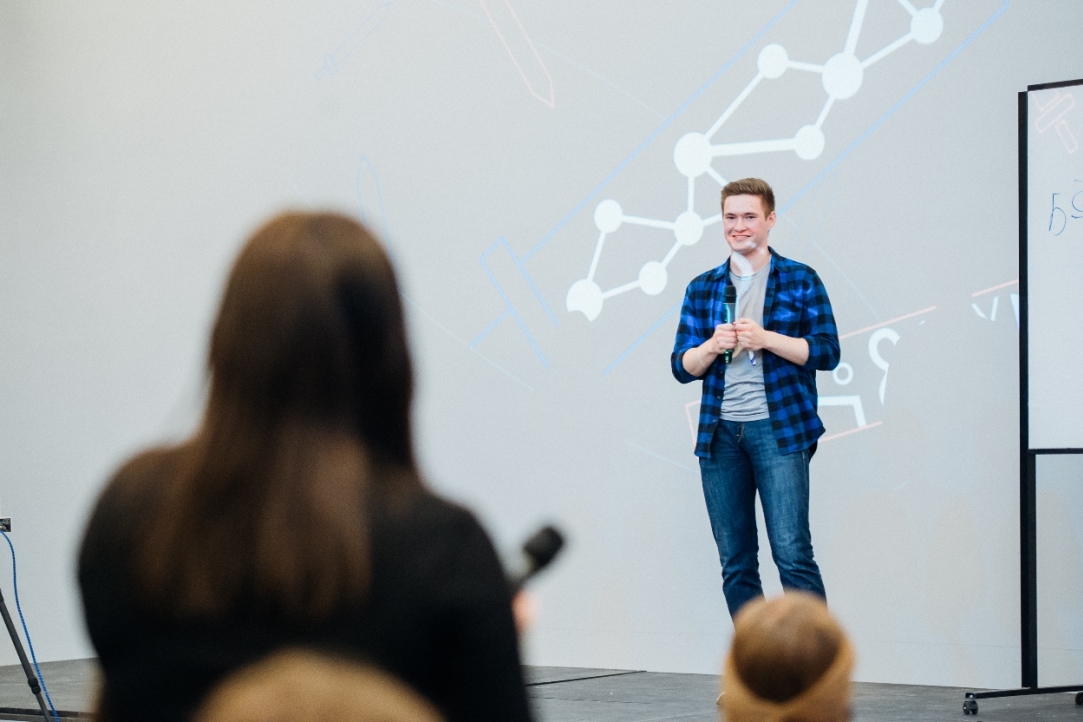
The fifth season of HSE Science Battles is currently underway, with the Sber office serving as a venue for another stage of the battle. Four speakers fought for a place in the finals by presenting their research in a ‘TED Talks’ format. The HSE News Service reports on highlights from the event, including how to explain to your grandmother that GMOs aren’t dangerous, what font you should use to develop your memory, and who ‘hate-watchers’ are.
HSE Science Battles are one of the stages of Science Slam, a university league that promotes science competitions in higher education. HSE Science Battles have two features that make them unique: speakers do not use visual presentations, and winners are selected by joint vote of the jury and the audience. The audience in the room votes via an app on their smartphones.
Speakers of the Third Semi-Finals were Vasilisa Vashchenko and Polina Kochetkova (third-year students of Sociology), Ekaterina Sheychenko (third-year student of Chemistry), Timofey Berezner (first-year student of Cognitive Sciences and Technologies: From Neuron to Cognition), and Mark Rofin (third-year student of Applied Mathematics and Information Science).
The jury consisted of Andrey Kozhanov, Director of the Centre for Student Academic Development and Senior Lecturer at the Faculty of Social Sciences; Sergey Karapetyan, Head of the Faculty of Computer Science External Communications Unit; Ainur Ragimova, Research Fellow at the Centre for Cognition & Decision Making; and Boris Dolgin, Head of the Research Expertise Unit at the Polytechnic Museum Office of Research and Research Communications, Member of the Board at Evolution Fund.
Fantastic Hate-Watchers and Where to Find Them
Why do we continue consuming content even when we don’t like it? Third-year Sociology students Polina Kochetkova and Vasilisa Vashchenko tried to answer this question in their study of hate-watching on social media. ‘While previously, bloggers tried to attract an audience by being appealing, today, more and more of them are trying to get publicity through ongoing hate, or, in other words, hate-watching,’ said Polina Kochetkova. To make up a social portrait of typical hate-watchers, the researchers conducted a survey of over 700 internet users.
They found that hate-watching can differ in nature. The researchers used images of animals to visualise the types. The ‘Cyberbullying Pig’ is the most aggressive type of hate-watcher, one who actively expresses their dissatisfaction on social media. This kind is typical for males with low levels of education and low subjective wealth: a common hater type.
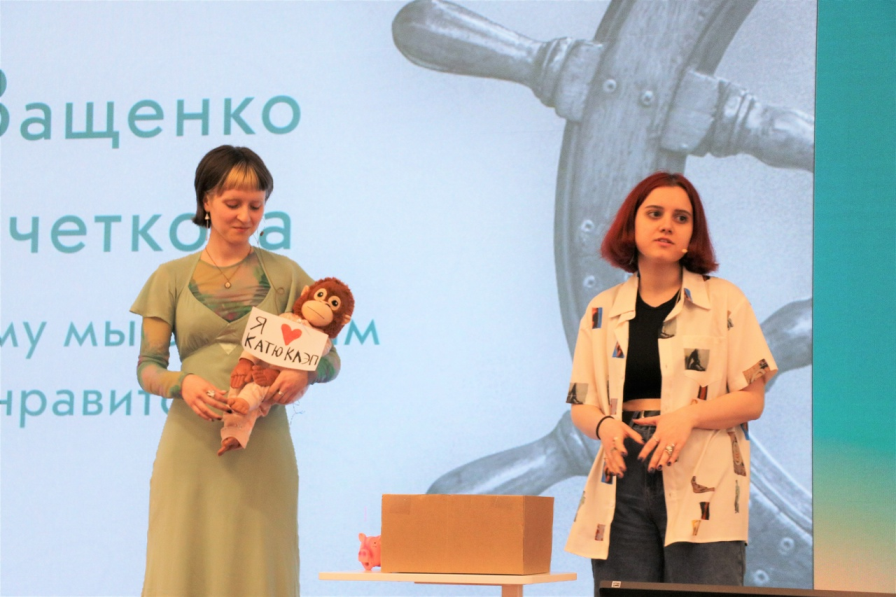
The second type of hate-watcher is more complicated: initially, such consumers are linked to bloggers through warm, although unilateral (or, in sociological language, ‘parasocial’) interactions. But if the content-maker stops satisfying the needs of the viewer but the connection remains strong, hate-watching emerges. The ‘Fanatic Monkey’ embodies such a viewer’s addiction to mass culture and an unstable social environment.
The third group is made up of people who consume unpleasant content not only due to hate or a deep connection, but in order to demonstrate a form of superiority to others. The ‘Intellectual Tiger’ is a passive hate-watcher who watches content that they believe to be low-level, usually accompanied by other intellectuals, in order to laugh at it and have fun.
Detailed knowledge of one’s ‘haters’ has a specific industrial application. ‘Bloggers are beginning to include not only their fans, but their hate-watchers in the target audience, while a thorough understanding of their viewers helps them pull the right strings,’ the researchers concluded.
Glutamates and Dihydrogens: What Grandmothers Are Afraid to Eat
Everyone has heard of the dangers of sodium glutamate, colourants, and different GMOs in food. But are they really harmful and if so, how? Ekaterina Sheychenko, third-year student of Chemistry, decided to get to the bottom of the matter. ‘Actually, a knowledge of chemistry helps. I can check for sure whether a certain product is dangerous,’ she said.
Furthermore, she continued, people are scared of unfamiliar chemical names and facts taken out of context. She gave an example of a substance called ‘dihydrogen monoxide’: ‘This is a liquid without colour, taste or smell, which is used in many products, from nuclear reactors to pesticides, to poisons. Everyone who has ever taken it has died with 100% certainty. There is even a petition on Change.org to prohibit dihydrogen monoxide in manufacturing. Nevertheless, food products still contain it.’ With such a description, 98% of respondents said that the use of this substance should be discontinued, or at least food products that contain it should have a relevant label. So, what exactly is this dreadful substance? Ekaterina Sheychenko said that she brought it with her. And took from her bag… a bottle of water.
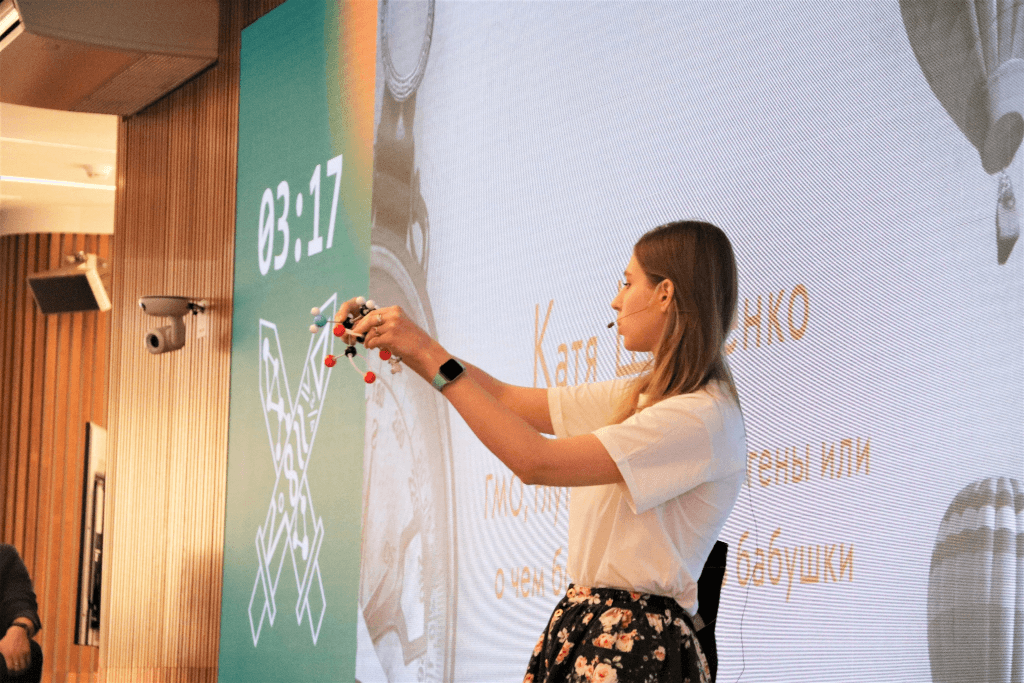
This is how we develop inaccurate beliefs about many substances and elements, such as sodium glutamate. According to Ekaterina, glutamate is one of the key neurotransmitters in the spinal neural system. What makes it different from sodium glutamate is ions (charged particles) of sodium. The latter is found in salt and is essential for normal body functioning. The US Food and Drug Administration (FDA) carried out many studies and definitively lists sodium glutamate as a safe food additive.
Another scary abbreviation is GMO (genetically modified organism). Genetic engineering changes genetic information. For example, in one Asian country, someone decided to modify carrots by adding a vitamin A gene to them, since many people in that region suffered sight loss. But people heard that the fields were planted with genetically modified carrots, protested, and forced the project to be shut down.
Genetic engineering helps decrease the number of pesticides used in agricultural production, which are harmful to humans and the ecosystem. It also can make cats hypoallergenic, which is good news for people with allergies. Another vivid example is farms of bacteria that grow insulin, which is essential for people with diabetes. Even if someone wants to cause harm by using genetic engineering, they won’t be able to do it, since all the products are clinically tested.
Ekaterina Sheychenko believes that is essential to educate a wide audience. The myth of the danger of GMOs is beneficial to manufacturers and marketing managers, since they would can sell products labelled ‘GMO free’ at double the price.
Fonts Help Those Who Help Themselves
First-year student of the master’s programme Cognitive Sciences and Technologies: From Neuron to Cognition Timofey Berezner decided to investigate how fonts impact the way we memorise information. In 2011, American researchers found the so-called ‘disfluency effect’ among school students: the more complicated and uncommon the font, the more time it takes to process and the deeper the information is remembered. The effect soon became an object of media discussion. ‘Just imagine: if a student has to learn something the night before an exam, all they need to do is to change the font of their notes to a disfluent one—and the job is done,’ Timofey Berezner assumed.
However, repeated experiments by researchers across the world did not confirm this effect, and Timofey decided to check the corelation himself. As part of his experiment, he asked two groups of people to memorise words or sentences written in fluent or disfluent fonts. He didn’t observe any disfluency effect.
‘If your study does not find the effect, it is important to communicate it to the world. This is how we can bust the myths that exist in research publications,’ he concluded.
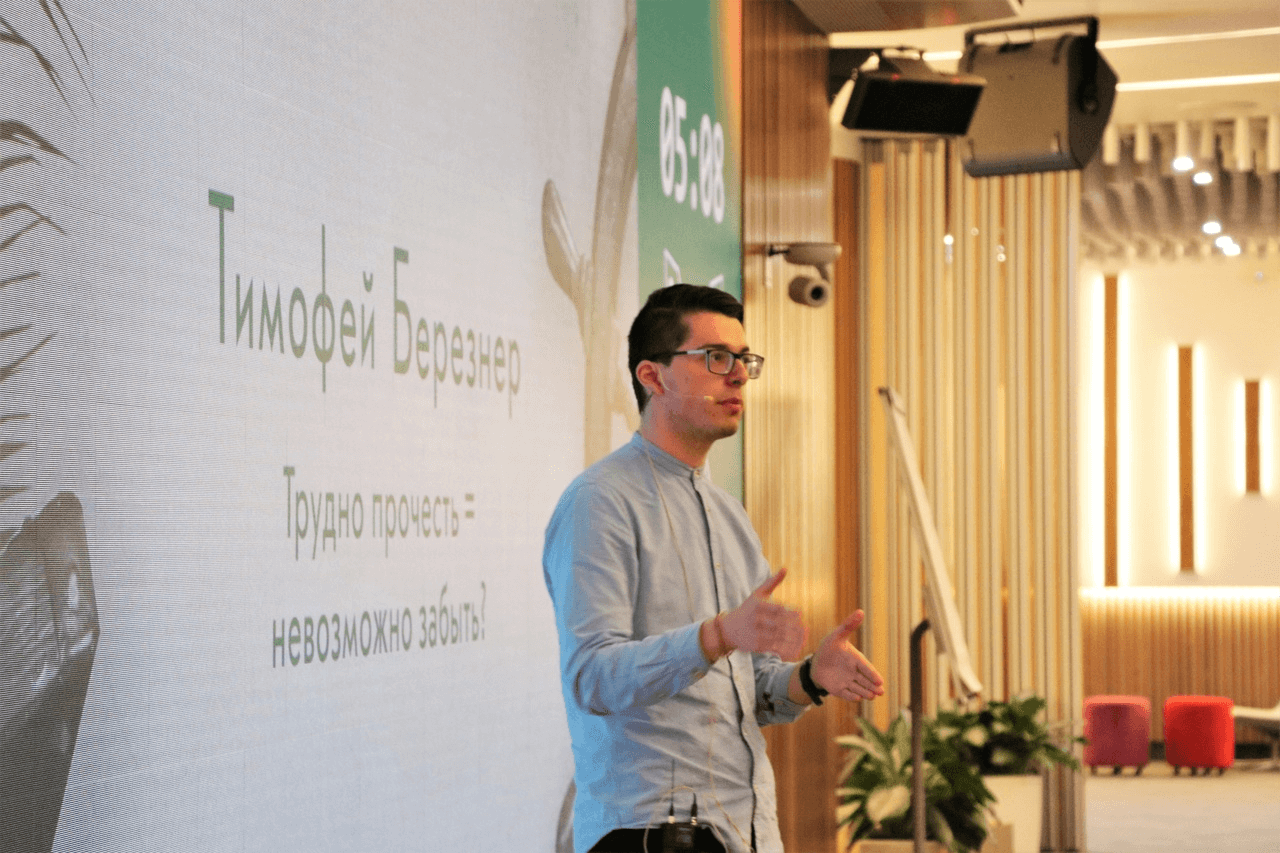
How to Negotiate with Your Voice Assistant
Many people start their mornings by asking their voice assistant to turn off the alarm. The artificial intelligence in the device becomes our life partner in a sense. Mark Rofin, third-year bachelor’s student of Applied Mathematics and Information Science, studied contemporary machine learning algorithms and found out how to teach a neural network when you don’t have much data.
BERT is a neural network that transforms human speech into text. During the teaching process, it learns how human language works. At first, it knows nothing and can do nothing until it is exposed to some examples and given a sequence of actions. The problem is that the number of examples should be very high, and that’s why companies today hire specialists to invent them. This work is rather boring and routine: today, we can make neural networks invent such examples independently. They know lots of texts, so they can build sentences. One neural network, T0, was taught by several big companies simultaneously; it was published in open access, and is now used by other companies after adjustment to their needs.
Mark and his team took BERT, taught it on small real data, then took T0 and taught it to generate examples. They ran a million experiments in order to find good parameters that would return acceptable quality, and found that it is possible to get a statistically significant improvement in the quality of command recognition. This allowed them to create their own speech recognition programme. ‘We are at a point when we can create programmes to teach other programmes to talk with humans. This sounds very cyberpunk, which, honestly, gives me thrills,’ Mark Rofin said.
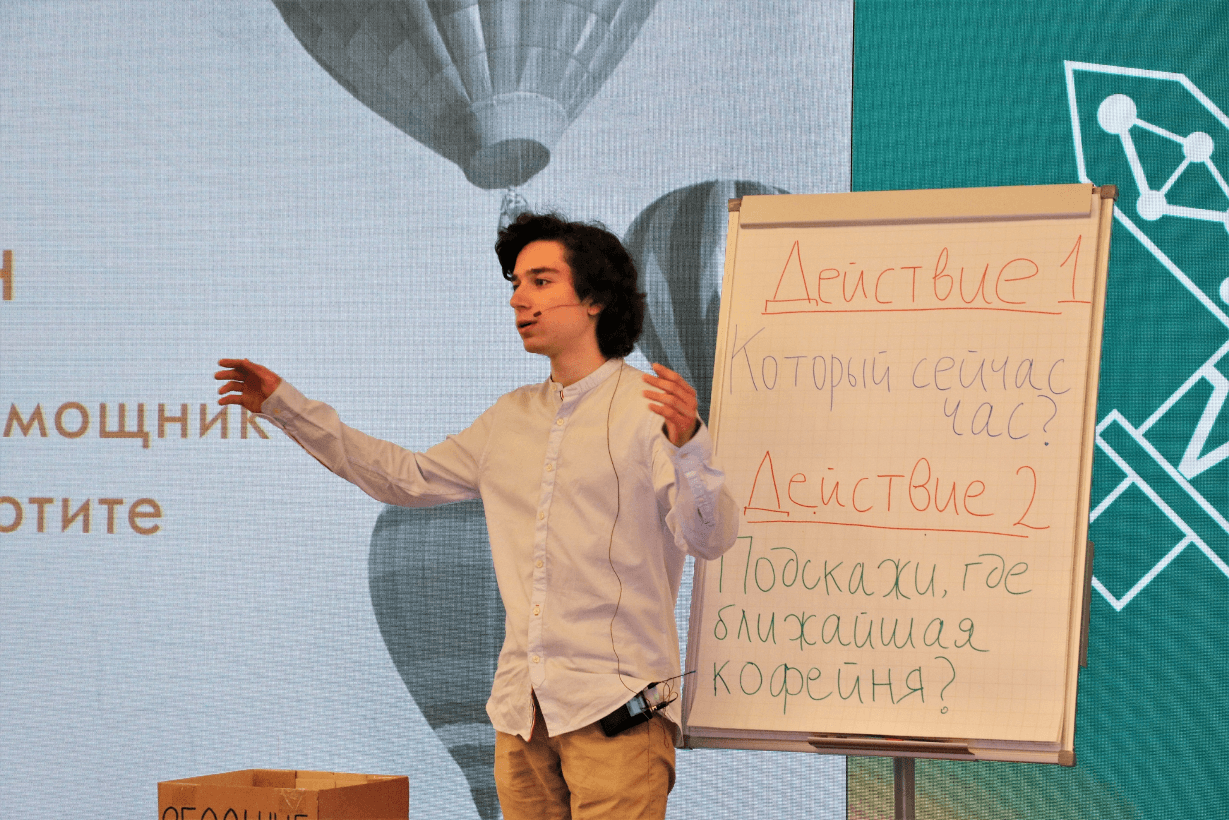
After voting by the viewers and jury, Timofey Berezner was named winner of the third semi-finals for busting the myth about the impact of disfluent fonts on the process of memorisation.
Science Battles is a student popular science project that has been held at HSE University since 2016. Early-career researchers present their studies in various fields to the audience without the use of visual presentations, using only their public speaking skills and props. Each Science Battle consists of talks by four speakers, followed by a vote by the audience and the jury. The winner goes on to the season’s finals and gets an opportunity to fight for the main prize—an academic travel grant. The next Science Battles will take place in autumn 2022.
Text by Milena Serkebayeva and Anastasia Kirillova, research assistants at the Laboratory of Economic Journalism
See also:
From Ingenious Fungi to Post-feminism: HSE University Hosts Season’s Last Science Battles Semi-Final
Season VI of Science Battles at HSE University is entering the homestretch. The June semi-final determined the list of finalists and helped many viewers choose their favourites. This time, young researchers decided to figure out how to conduct a police lineup without destroying a person’s life, as well as how to improve a child’s academic performance without instilling neurotic perfectionism. They also found out that fungi and mould help heal scars and save the environment, and that adherents of post-feminism have very mixed feelings about their own images on TikTok.
From Cultural Appropriation to Prison Jargon: Second Semi-Final of Science Battles Takes Place at HSE University
On March 19, the second semi-final of the fourth season of HSE University Science Battles brought together the topics of cultural appropriation, pharmacological neural networks, prison jargon, and ‘diseases’ of higher education on the same stage. Students from various degree programmes presented their projects in the Community space. Read on to find out more about the performances featured in the semi-finals.
Robot Rights and Talking Babies: Discussions at HSE Science Battles
Four young scientists competed in the second semi-final of the fifth season of HSE University Science Battles, which was held at HSE Cultural Centre. What tasks lead students to cheat on exams, how babies learn to talk, whether artificial intelligence is subject to copyright, how to deal with false modesty — each researcher presented their work while the audience and the jury chose a winner to compete for the main prize of the season — an academic travel grant.
‘It Was Interesting to Showcase a Unique Student Project’
Held as part of the Second New Knowledge Marathon, the fourth HSE Science Battles attracted a wide audience. HSE Students Frol Sapronov, Marina Kasyulina, and Vsevolod Nikolsky took part in the competition’s new televised format to demonstrate how to talk about science vividly and in simple terms understandable to any audience.
HSE Science Battles Wrap Up Third Season
What professions in Russia are considered ‘dirty’? Do computers have empathy? What happens when the brain incorrectly predicts how we feel? The answers to these and other questions were tackled at the final round of the HSE Science Battles, which was held online for the first time this year. Read on to find out which performance was rated highest by the audience and jury and why the Science Battles are a must-see for everyone.


